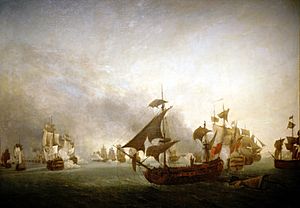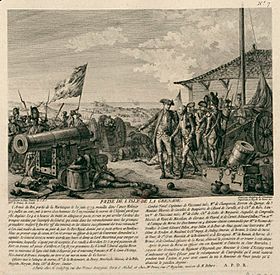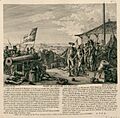Battle of Grenada facts for kids
Quick facts for kids Battle of Grenada |
|||||||
|---|---|---|---|---|---|---|---|
| Part of the American Revolutionary War | |||||||
 Battle of Grenada, Jean-François Hue |
|||||||
|
|||||||
| Belligerents | |||||||
| Commanders and leaders | |||||||
| Strength | |||||||
| 25 ships of the line | 21 ships of the line | ||||||
| Casualties and losses | |||||||
| 173 killed 773 wounded |
183 killed, 346 wounded |
||||||
The Battle of Grenada was a big naval battle that happened on July 6, 1779. It took place in the West Indies, near the island of Grenada. This battle was part of the American Revolutionary War, where the American colonies fought for their freedom from Great Britain.
In this sea fight, the British Royal Navy went up against the French Navy. The British fleet, led by Admiral John Byron, tried to help Grenada. But the French forces, led by the Comte D'Estaing, had already captured the island.
Admiral Byron thought his fleet was stronger. So, he ordered his ships to chase and attack the French fleet as they left Grenada. But his attack was messy, and the French actually had more ships. The British fleet was badly damaged, but no ships were sunk on either side. A famous naval historian, Alfred Thayer Mahan, said it was the worst loss for the British Navy since 1690!
Contents
Why Did the Battle of Grenada Happen?
France Joins the War
In early 1778, France decided to help the American colonies in their fight for independence. This meant France and Great Britain were now at war. French Admiral the Comte D'Estaing arrived in the West Indies with a fleet of 12 large warships. Around the same time, a British fleet also arrived.
The British then captured St. Lucia, an island that belonged to France. The British used St. Lucia as a base to watch the main French base on Martinique. This is where Admiral D'Estaing was staying.
More Ships Arrive
In January 1779, the British fleet got even more ships. Admiral John Byron took command of the British ships in the area. Over the next few months, both the French and British fleets grew stronger. The French fleet became a bit more powerful than the British.
On June 6, Admiral Byron left St. Lucia to protect British merchant ships. This left Admiral D'Estaing free to act. D'Estaing and Governor Bouillé decided to attack nearby British islands.
French Attacks on Islands
Their first target was Saint Vincent. It fell to the French on June 18. D'Estaing then wanted to capture Barbados, another important British island. But the winds made it too hard. So, he changed his plan and headed for Grenada instead.
The French fleet arrived at Grenada on July 2. They attacked the island's main defenses on July 3. By July 4, the British on Grenada had to give up. On their way, the French fleet also added a 50-gun ship called Fier Rodrigue to their battle line.
Byron Changes Course
Admiral Byron heard about the French attacking Saint Vincent. He was sailing to recapture it. But when he got news that the French were at Grenada, he quickly changed course to find them.
The British fleet had 21 large warships and 1 smaller ship called a frigate. Byron was also protecting ships carrying troops. So, three of his warships had to stay with these transport ships.
Admiral D'Estaing learned on July 5 that Byron was coming. He quickly put most of his troops back on his ships. His fleet had 25 large warships and many smaller ships. Admiral Byron didn't know how strong the French fleet really was. He didn't know that D'Estaing had gotten more ships from Europe.
How the Battle Unfolded
The French ships were anchored near St. George's Town on the southwest side of Grenada. The British ships approached during the night.
At 4:00 AM, when the British fleet was seen, D'Estaing ordered his ships to get ready. They formed a long line, heading north. This made it hard for the British to see how many ships the French really had. Thinking he had more ships, Admiral Byron ordered a "general chase." This meant his ships should attack the French wherever they found them.
When Byron finally saw how many French ships there were, he tried to get his ships back into a battle line. But it was too late. The British attack was messy and confused. Some British ships, like Fame and Lion, got separated. They were badly damaged. The Lion had to sail away to Jamaica to avoid being captured.
The French did not lose any ships. They eventually pulled away from the battle. The British lost 183 sailors killed and 346 wounded. The French lost 190 killed and 759 wounded.
What Happened After the Battle?
After the battle, D'Estaing went back to Grenada to fix his ships. Byron went to St. Kitts to do the same. The French admiral did not use his stronger fleet to attack more British islands in the West Indies. Byron returned home in August. D'Estaing later worked with the Americans in an attack on Savannah, but it wasn't successful. He also returned to Europe.
The battle was an important step for Ganteaume, who was 22 years old at the time. He served on the Fier Rodrigue and later became a Vice Admiral in the French Navy.
Images for kids




